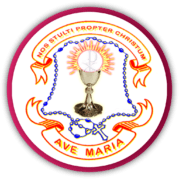A Silent Hermit:
Servant of God Antony Susainather

Servant of God Antony Susainather A Silent Hermit
‘The Mouna Muni’ (Silent Hermit) of the Rosarians has entered into Eternal silence: this was the unexpressed feelings of the crowd that attended the funeral of Rev. Fr. Antony Soosainathar C.R. who rested in the Lord on 8th June 1968.
Indeed he was a man of deep silence; hence a man of few words. He spoke less but achieved much as a Pastor to his flock and a guiding stat to several in the Congregation of the Rosarians.
The remarkable quality that the people of God emulated from Fr. Antony Soosainathar C.R. was his zeal for souls and his desire for renovation of various churches. “Repair my church” was the clarion call to Fr. Susainathar. Imitating St. Francis of Assisi he repaired and renovated several churches above all he renewed the spirit of the people of God by founding several sodalities and pious associations. These bear witness to his zeal and zest or souls, even today.
He was a liberator and a reformer who liberated souls from the clutches of Satan. As a social reformer he set free the oppressed and the low caste citizens from the fetters of bonded labour, social taboos and suppressed status. The people of Uvari parish in Tuticorin Diocese are the living witnesses to this.
His utter trust in God made him follow the foot steps of Abraham, the Father of the believers. Like Abraham he left everything, his people, his diocese and his active ministry and embraced the silent hidden life of Nazareth by joining the Congregation of the Rosarians at the age of 55. It was indeed a vocation within a vocation which he cherished and nurtured as a diocesan priest. His deep devotion to the Eucharistic Lord and Our Blessed Mother fostered him to kneel before the Blessed Sacrament and recite the Rosary, contemplating the mysteries. Thus he spent several hours before the Eucharistic Lord making reparation for the sins of humanity.
As he advanced in age he was pleased to fulfill the act of reparation by his physical suffering and mental agonies with exemplary patience. The first step he had set on his native soil at Tuticorin as a Rosarian Monk was a step stumbled on mockery and butt. People derided him whenever he attempted something good for the monks in the two monasteries he founded in India. With deep humility and utter silence he accepted everything patiently before the Eucharistic Lord in reparation.
With his injured at a fall from his horse on a missionary journey to a parish he was always faithful to the Rosarian charism of ‘ora et labora’. His fractured hip, and paralysis strangulated hernia, were due to the attack of paralysis he lost the power of speech always thorns in his flesh, yet he endured them with no complaint and was consoled by his Master as in the case of St. Paul: “My grace is sufficient for you to suffer and suffer more”. Perhaps this was how the Lord consoled him. Hence he, like his Master has his Calvary for 14 years of sufferings similar to the 14 Stations of the Cross. He might have been whispering in his heart the words of St. Paul to the Galatians “I have been crucified with Christ and it is no longer I who live but it is Christ who lives in me”. He always desired to stand at the foot of the Cross in his sufferings, emulating the Mother of Sorrows in whose honour he dedicated a Church when he was a diocesan priest.
Fr. Antony Soosainathar’s memory is cherished by the people with whom he lived; to whom he ministered. At the time of his burial several devotees of his, placed rosaries and metals and souvenirs on his body and presence them as relics even after 40 years of his death. When he was laid to rest, people were speaking of his many miracles and favours received through his prayers and sufferings. Rosary in hand, prayer in mind, and contemplation in life Fr. Antony emulated the people of the locality and was a living Saint for Reparation and a Suffering Servant of God. This is the spiritual heritage he has left for the pilgrims who visit his tomb and pray for famous through his intercession. His Canonization process is in the Roman phase.
